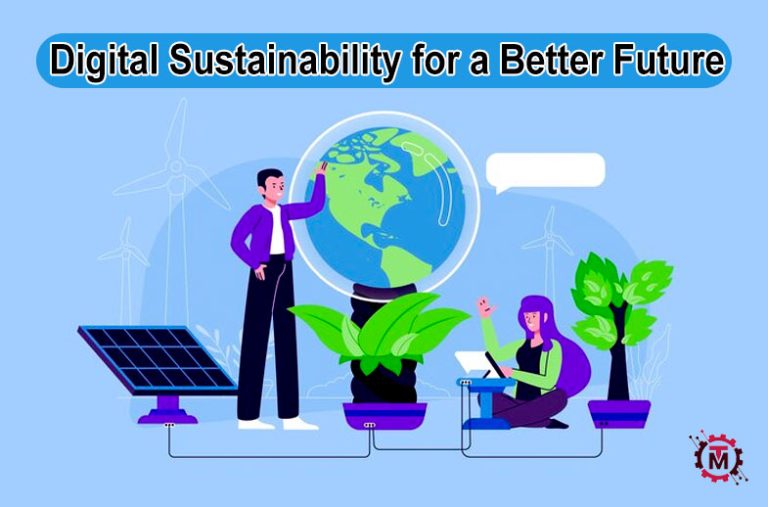In today’s world of rapidly developing technologies, digital sustainability is an important condition for building a better tomorrow. However, the more our society faces dependence on digital technologies, the higher is the requirement to apply these innovations in a proper and harmonious way with nature. To attain digital sustainability, eco-friendly practices must be incorporated during the entire life cycle of a digital product, from planning and implementation through termination. This blog discusses the important points to reach digital sustainability for a bright future.
What is Digital Sustainability?
Digital sustainability is centred around the everyday technological tools businesses use to minimize their environmental footprint. This typically involves modifying current infrastructure or implementing fresh initiatives to advance toward sustainability objectives. For instance, an office could choose a digital filing system over a paper-based one to minimize environmental impact. A factory might improve efficiency and reduce energy waste by implementing sensors on machinery. Furthermore, a steel manufacturer could employ sophisticated automated software to minimize waste.
Tips to Achieve Digital Sustainability for a Better Future
Achieving digital sustainability is crucial for creating a better future. It involves managing digital resources to meet current needs without compromising the ability of future generations to meet their own needs. Here are some tips to promote digital sustainability:
- Invest in Green Technology
- Use Data For Decision-Making
- Align Digital Strategy
- Apply Predictive Maintenance
- Encourage Flexible Work Practices
Invest in Green Technology
Prioritizing investments in environmentally friendly technology is essential for harmonizing digital transformation with sustainability goals. Although digital technologies improve operational efficiency, they often entail significant energy consumption. Energy-efficient devices help mitigate this impact, and adopting green technologies, like renewables, diminishes dependence on fossil fuels. This conserves energy and lowers carbon emissions, resulting in long-term financial advantages.

Use Data For Decision-Making
The importance of data must be balanced in the context of digital transformation and making decisions that prioritize sustainability. It offers anticipatory perspectives, uncovers inefficiencies, and pinpoints opportunities for enhancement. This data empowers you to formulate plans to minimize energy consumption and design sustainable products tailored to customer preferences. Additionally, data is a tracking tool for monitoring sustainability progress, a crucial aspect for engaging stakeholders and facilitating external communication.
Align Digital Strategy
Aligning your digital strategy with your office’s sustainable practices is essential when leveraging digital transformation to enhance sustainability. By integrating the two and investing in eco-friendly digital tools, you can fulfill your commitment to the planet while fostering digital growth. This alignment demonstrates a robust dedication to sustainability for both employees and consumers, ultimately bolstering the business’s reputation.
Apply Predictive Maintenance
Anticipatory maintenance to leverage sensors, data analytics, and machine learning to facilitate sustainability via digital transformation in predicting equipment failures holds paramount importance. This approach enhances operational efficiency, mitigates resource wastage and service disruptions, prolongs the equipment’s lifespan, and reduces energy consumption and maintenance expenditures. Ultimately, it yields positive outcomes for both the environment and the economy.
Encourage Flexible Work Practices
Encouraging a hybrid work model supported by digital tools is crucial for establishing an environmentally friendly work environment. Remote work to enabled by cutting down on daily commuting and office space to reduce carbon emissions and energy consumption and boost employee satisfaction. This fosters social sustainability that enables businesses to contribute substantially to their ESG goals while enhancing operational efficiency.
Tools to Achieve Digital Sustainability

Digital sustainability involves using technology and digital resources to minimize adverse environmental impacts, promote social responsibility, and secure long-term viability. Here are some tools that help to achieve digital sustainability:
- Cloud Computing Solutions
- Internet of Things (IoT)
- Data Analytics Tools
- E-Waste Recycling Solutions
Cloud Computing Solutions
Cloud computing platforms such as Microsoft Azure and Amazon AWS enable businesses to store and oversee data on distant servers to eliminate the necessity for physical in-house servers. This transition minimizes energy consumption by eliminating the requirement to cool and power numerous on-site servers. In addition to promoting energy conservation, cloud computing provides scalability, flexibility, and accessibility to enhance overall business efficiency and support sustainability initiatives.
Internet of Things (IoT)
IoT devices like smart meters, industrial sensors, or connected office gadgets like Google Nest actively monitor real-time energy and resource usage. By furnishing valuable data, these devices optimize efficiency, reduce waste, and minimize costs. For instance, intelligent thermostats adjust heating and cooling by occupancy, minimizing energy inefficiency. Similarly, sensors in the industrial Internet of Things (IoT) can monitor the well-being of machinery, forecast maintenance requirements, and avert failures and inefficiencies.
Data Analytics Tools
Software programs like Tableau and Google Analytics that solutions in data analytics can process massive datasets to find patterns, and trends related with sustainability. These instruments help companies track energy usage, control waste production, assess the success of green activities and identify improvement opportunities. The derived insights underpin data-driven decisions, thereby enabling companies to improve their operations for greater efficiency and sustainability.
E-Waste Recycling Solutions
The tools used for e-waste recycling make sure that the gadgets are dealt with and disposed of appropriately. EcoATM and other merchants own kiosks built to collect used electronic gadgets in order to support recycling and reduce the amount of waste dumped at landfills. Companies such as Apple and Dell provide the trade-in programs designed to recycle and refurbish their products. Such firms as ER International and TerraCycle provide e-waste recycling services for enterprises, delivering a guarantee that electronic waste is appropriately and securely discarded.
Conclusion
Digital sustainability is necessary to ensure the course that our joint future takes leads to a greener and more resilient path. In their turn, businesses can act as some sort of game changers by investing in eco-friendly technology which uses data to make informed decisions, matching digital strategies with sustainable practices, making use of preventative maintenance, and supporting the work flexibility. Acceptance of technology such as cloud computing, IoT, data analytics, e-waste recycling solutions and teleconferencing platforms enables organisation to participate in creating a sustainable and resilient digital world.







